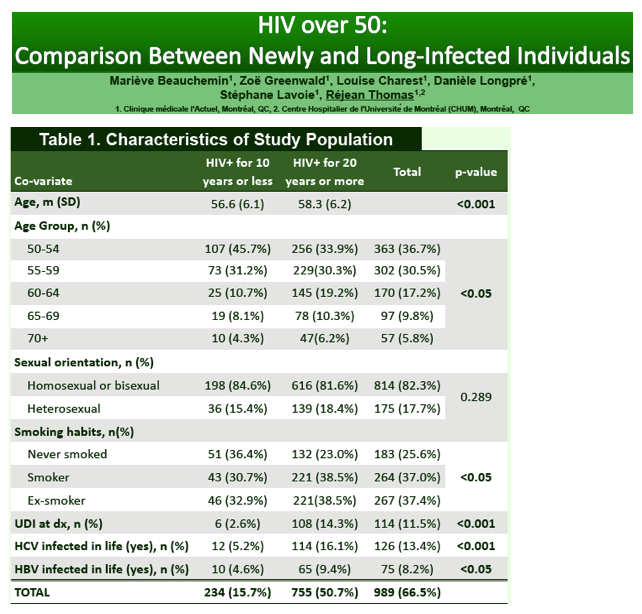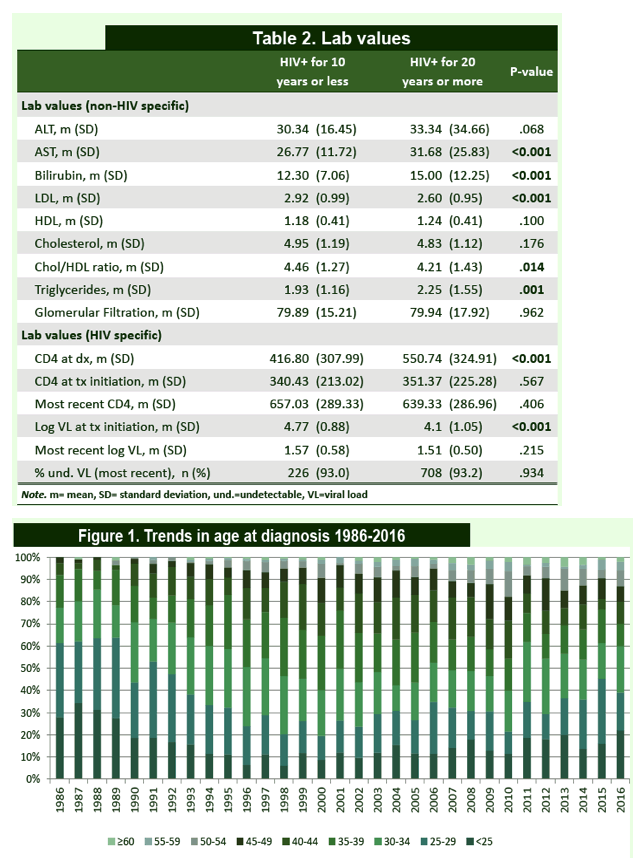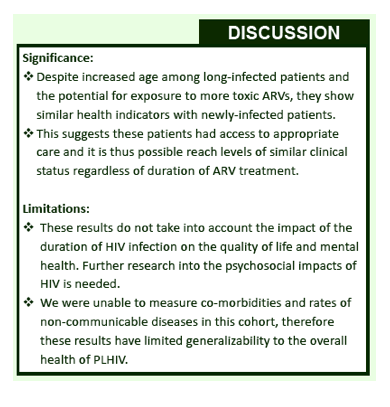 |
 |
 |
| |
Impacts of HIV Duration (Under 10 vs Over 20 Years) in People 50 or Older
|
| |
| |
Download the PDF here
16th European AIDS Conference, October 25-27, 2017. Milan
Mark Mascolini
People 50 or older and infected with HIV for 20 or more years differed in several ways from 50-or-older people infected 10 or fewer years in a 989-person Montreal comparison [1]. Despite these (often liver-related) differences, the two groups had many similar lab values, including current CD4 count and viral load.
In high-income countries growing proportions of HIV populations now exceed 50 years in age. At Montreal's Clinique medicale l'Actuel, a sexual health clinic, 14% of people diagnosed with HIV in 2016 were 50 or older and 52% of HIV-positive people in care are 50 or older. Despite a growing research focus on HIV in older adults, the Montreal team pointed out, little is known about the interaction between lifetime duration of HIV infection and aging.
To address that question, the researchers created two 50-or-older groups according to duration of HIV infection: 10 or fewer years (newly infected people) and 20 or more years (long-infected people). They compared numerous demographic and health-related variables in these two groups.
Among 1488 people 50 or older and in care at the clinic, 234 (16%) were infected for 10 or fewer years and 755 (51%) for 20 or more years. The newly infected group had a younger average age (56.6 versus 58.3, P < 0.001) and a lower proportion 65 or older (12.4% versus 16.5%, P < 0.05). The newly infected and long-infected groups did not differ in proportion of gay/bisexual men (84.6% and 81.6%, P = 0.289). But the newly infected contingent had a significantly lower proportion of current and former smokers (current 30.7% versus 38.5%, P < 0.05), a lower proportion of drug injectors (2.6% versus 14.3%, P < 0.001), and lower proportions exposed to HCV (5.2% versus 16.1%, P < 0.001) or HBV (4.6% versus 9.4%, P < 0.05).
Probably because of the lower hepatitis virus rates, the newly infected cohort had lower aspartate aminotransferase and lower bilirubin than the long-infected group (P < 0.001 for both), though average values for long-infected people remained in the normal range. The newly infected group had significantly higher "bad" low-density lipoprotein cholesterol (2.92 versus 2.60 mmol/L, P < 0.001) and higher (worse) total-to-high-density lipoprotein (HDL) cholesterol ratio (4.46 versus 4.21, P = 0.014) but lower triglycerides (1.93 versus 2.25 mmol/L, P = 0.001). Alanine aminotransferase, HDL cholesterol, total cholesterol, and glomerular filtration rate did not differ substantially between newly-infected people and long-infected people.
The newly infected group had a significantly lower average CD4 count at HIV diagnosis (417 versus 551, P < 0.001) and a higher viral load when antiretroviral therapy began (4.8 versus 4.1 log10 copies, or about 63,000 and 12,600 copies, P < 0.001). But most recent average CD4 counts (657 and 639) and viral load (1.6 and 1.5 log10 copies, or about 40 and 30 copies) did not differ significantly between the newly infected and long-infected groups. In both groups 93% had a currently undetectable viral load.
The Montreal team concluded that the long-infected group has lab values similar to newly the infected group despite older average age and longer use of antiretroviral therapy. The researchers believe these findings suggest long-infected individuals had appropriate care that enabled them to attain a clinical status similar to more recently infected older people. They cautioned though, that their analysis does not consider the impact of longer HIV duration on quality of life and mental health. And the study did not compare rates of comorbidities or related markers like bone mineral density.
Reference
1. Beauchemin M, Greenwald Z, Longpre D, Lavoie S, Charest L, Thomas R. HIV over 50: comparison between newly and long-infected individuals. 16th European AIDS Conference. October 25-27, 2017. Milan. Abstract PE23/21.
Poster pdf attached
Download the PDF here



|
| |
|
 |
 |
|
|